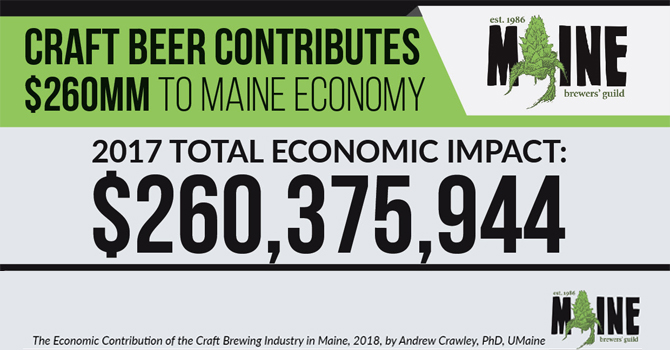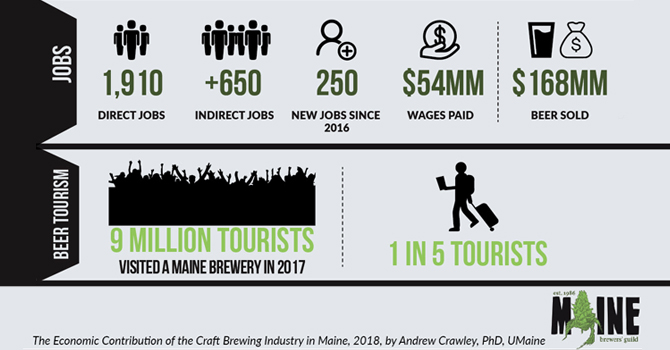
Maine’s craft beer industry contributed more than $260 million to the state’s economy in 2017, according to a biennial economic impact study conducted by the University of Maine in conjunction with the Maine Brewers’ Guild.
The report, which examined data from 2017, notes that in-state craft breweries generated more than $168 million in total revenue, while producing an estimated 319,590 barrels of beer.
Since the last economic impact report, which was released in February 2017 and examined data from 2016, the number of Maine craft breweries, as well as volume production and economic impact, has grown. According to the 2017 report, Maine’s craft breweries generated nearly $228 million in total economic impact in 2016, with more than $150 million in estimated revenue.
“Overall, I think the latest report shows that Maine is on an accelerated version of the national trend — in terms of the number of brewery openings, the shift towards smaller producers operating in small towns, and an increasing number of consumers who are making the shift away from macro and towards locally produced beer,” Maine Brewers’ Guild executive director Sean Sullivan told Brewbound.

The most recent economic analysis showed that the number of craft breweries operating in the state grew from just 14 in 2007 to more than 133 breweries last year. The majority of those beer companies — 87 percent — are small operations producing fewer than 1,613 barrels of beer.
Although Cumberland County, which includes Portland, is home to 46 craft breweries, the most in the state, each of Maine’s 16 counties had at least one craft brewery in operation in 2018. More than 10 breweries are now operating in both Penobscot and York counties, a press release noted.
“We talk about Maine beer like it’s a singular thing, but it’s over 130 business stories wrapped into one novel of economic success,” Sullivan said, via the release. “Anyone who has had the chance to visit a Maine brewery, meet a Maine brewer, or enjoy a Maine beer can take pride in knowing that they are supporting Maine and growing our economy.”
Maine breweries directly employed 1,910 full- and part-time workers statewide in 2017, an increase of 278 jobs from the previous year. Those breweries also paid more than $54 million in wages, and helped facilitate 650 additional jobs outside of the beer industry.

Although the number of breweries opening in Maine, as well as overall beer produced in the state has increased, average production figures and average salaries for the state’s large and small breweries both declined from 2016 to 2017.
In 2016, the average “large brewery” (Maine breweries producing more than 1,613 barrels of beer) produced 27,554 barrels and paid an average salary of $37,789. The average “small brewery” (Maine companies producing fewer than 1,613 barrels of beer) brewed 520 barrels of beer and paid a salary of $24,345.
However, in 2017, the average large brewery’s production was 20,398 barrels, and workers at those companies were paid an average salary of $29,789. Meanwhile, the average output at a small brewery was 434 barrels, and those companies paid an average salary of $22,521.
Sullivan explained that the average pay is likely down due to the addition of 278 new jobs as well as a number of really small breweries opening whose owners are reinvesting profits back into businesses as they grow.
“Most of these new brewers are these two-to-four-person outfits that are probably paying themselves $15,000 to $30,000,” he added.
Nevertheless, the report forecasts continued growth for Maine’s craft beer industry — 10 percent in 2019 and 15 percent in 2020 — as additional small breweries open and existing breweries scale up production.
“With the reputation Maine has for food and beer, and the support of incredible bars, restaurants, and entrepreneurs around the state, Maine’s craft beer industry still has room to grow,” Sullivan added, in the release.
